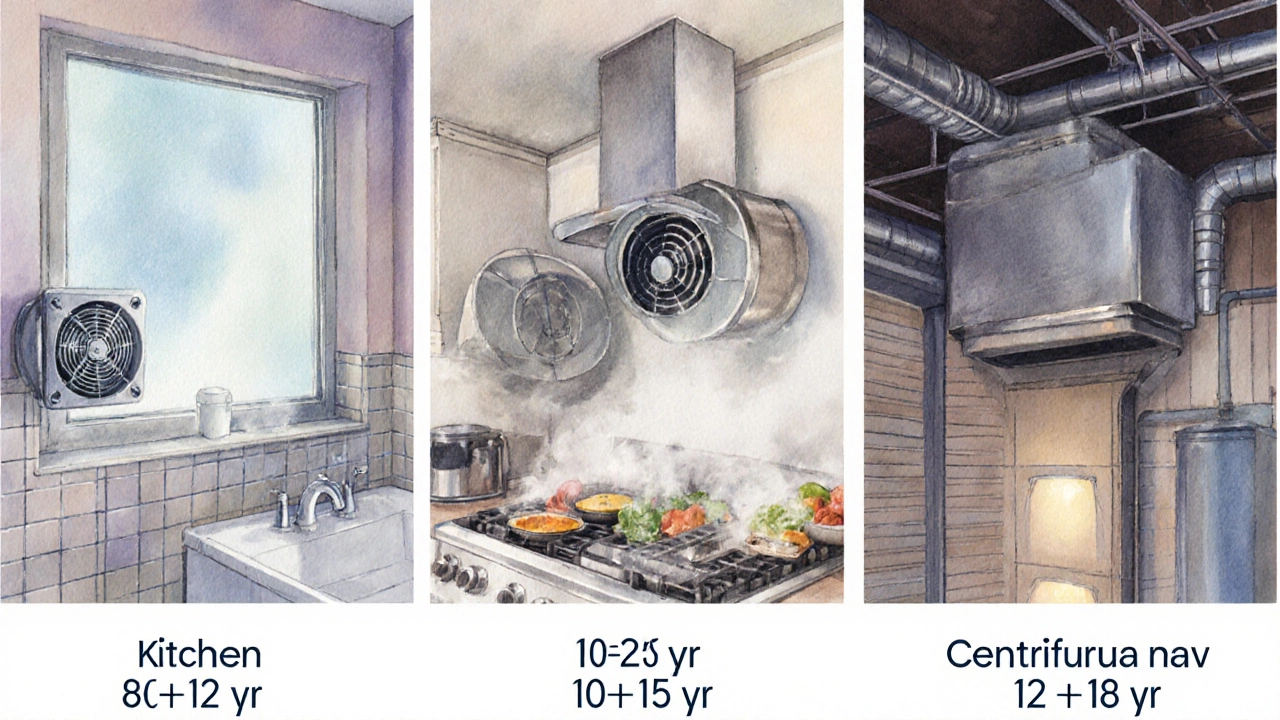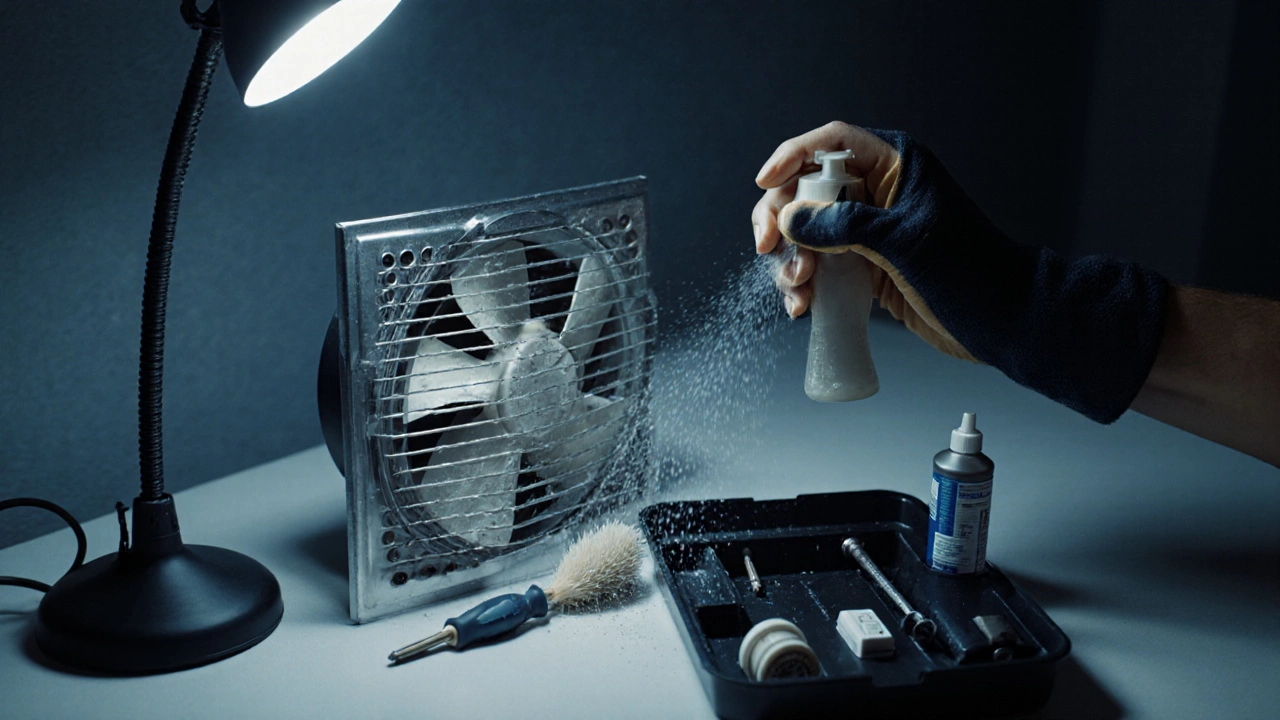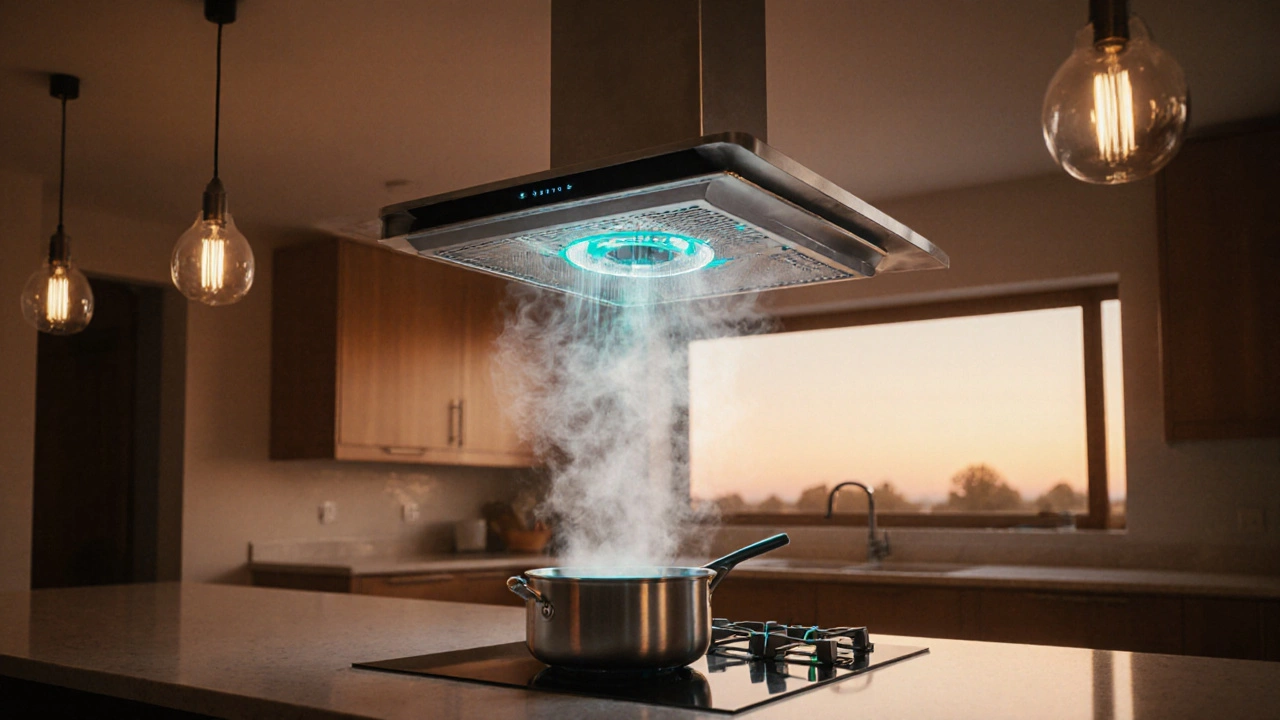Key Takeaways
- Most residential extractor fans last 8‑12 years, but kitchen models can reach 15 years with proper care.
- Motor quality, housing material, and operating environment are the biggest lifespan drivers.
- Regular cleaning, avoiding overload, and checking wiring can add 3‑5 years to a fan’s life.
- Warning signs like reduced airflow, unusual noises, or frequent circuit‑breaker trips mean replacement is imminent.
- When buying a new fan, match airflow (CFM), static pressure, and energy rating to the room’s size and use.
When you hear a whirr from the ceiling or the wall, an extractor fan is at work, pulling humid air, steam, or cooking fumes out of your home. But like any appliance, it won’t run forever. The extractor fan lifespan is a question many homeowners ask when the motor hums louder than usual or the airflow seems weak. Below we break down exactly how long you can expect a fan to stay reliable, what pushes its clock forward or backward, and how to get the most out of the unit you already own.
What Determines an Extractor Fan’s Lifespan?
Three core components decide how long a fan will keep spinning:
- Motor - the heart of the device. Brushless DC motors tend to outlive brushed AC motors because they generate less heat and have fewer wear points.
- Housing - usually made of galvanized steel, aluminium, or reinforced plastic. Corrosion‑resistant finishes add years, especially in humid bathrooms.
- Blades or impeller - balance and material affect vibration and wear. High‑speed fans with poorly balanced blades wear out sooner.
Beyond hardware, the environment plays a huge role. A fan constantly battling kitchen grease or bathroom humidity will see faster corrosion than one installed in a dry laundry room. Power quality matters too; frequent voltage spikes can fry motor windings.
Typical Lifespan by Fan Type
| Fan Type | Typical Lifespan | Key Material | Typical CFM |
|---|---|---|---|
| Bathroom wall‑mounted | 8-12 years | Galvanized steel housing, brushed AC motor | 70‑110 CFM |
| Kitchen ceiling‑mounted (axial) | 10-15 years | Aluminium housing, brushless DC motor | 150‑300 CFM |
| Centrifugal (high‑static‑pressure) | 12-18 years | Stainless‑steel housing, sealed motor | 120‑250 CFM |
| Utility/garage exhaust | 7-10 years | Plastic housing, AC motor | 80‑150 CFM |
These numbers assume normal residential use and manufacturer‑specified maintenance intervals. Premium units with sealed bearings and anti‑corrosion coatings can push the upper range even further.

Factors That Shorten an Extractor Fan’s Life
Even the toughest fan can be worn down quickly if you ignore a few simple pitfalls:
- Excess grease build‑up: Kitchen fans that aren’t cleaned every 2‑3 months develop fatty deposits on blades, causing imbalance and motor strain.
- Constant high humidity: Bathrooms without a functional humidity sensor run the fan at full speed all night, overheating the motor.
- Over‑sizing or under‑sizing: A fan that must move more air than its rating will overheat; a too‑small fan will run continuously, both shortening lifespan.
- Power surges: Unprotected circuits can melt motor windings. A simple surge protector adds a buffer.
- Poor installation: Loose mounting screws create vibration, leading to cracked housings and premature bearing wear.
Maintenance Tips to Extend Your Fan’s Life
- Clean the grille and blades every 2-3 months. Shut off power, remove the cover, wipe grease with a warm soapy cloth, and rinse the blades gently.
- Inspect the motor housing for rust. Lightly sand any surface corrosion and apply a rust‑inhibiting spray.
- Lubricate bearings if the fan uses oil‑lubed bearings. A few drops of lightweight machine oil can reduce friction.
- Check the wiring. Look for frayed insulation or loose connections; tighten terminal screws and replace worn wires.
- Test airflow annually. Hold a piece of lightweight paper near the outlet; if it hangs limp, the fan’s CFM has dropped and a deeper clean or replacement may be needed.
- Use a humidity‑controlled switch. In bathrooms, a sensor that turns the fan off after moisture levels fall can cut motor hours by 30‑40%.
Following these steps can easily add three to five years to a typical unit’s service life, turning a 10‑year fan into a 13‑year workhorse.
Warning Signs That It’s Time for a Replacement
Even with diligent care, fans eventually reach the end of their useful life. Keep an eye out for these red flags:
- Reduced airflow: If dishes take longer to dry or bathroom mirrors stay foggy, the fan’s CFM has likely dropped.
- Unusual noises: Grinding, squealing, or a high‑pitched whine usually points to bearing wear or blade imbalance.
- Frequent circuit‑breaker trips: An overloaded motor draws excess current and can be a fire hazard.
- Visible rust or corrosion inside the housing. Once the metal is compromised, structural integrity falters.
- Failure to start: A burnt smell or complete silence after flipping the switch often means the motor has failed.
When any of these issues appear, weigh repair costs against the fan’s age. Repairs on a unit older than 8‑10 years rarely make economic sense.

Replacing the Fan: Costs, Selection, and Installation Basics
New fans range from $60 for basic bathroom models to $300 for high‑performance kitchen units. Here’s what to compare before you buy:
| Factor | Why It Matters |
|---|---|
| Airflow (CFM) | Must match room size; undersized fans won’t clear humidity, oversized fans waste energy. |
| Static pressure rating | Crucial for ducted installations with bends; higher rating handles resistance better. |
| Motor type | Brushless DC motors are quieter, more efficient, and have longer warranties. |
| Noise level (dB) | Kitchen fans under 50dB are comfortable for open‑plan living spaces. |
| Energy rating | Look for “A+” or “A++” labels; they cut electricity use by up to 30%. |
| Warranty length | A 5‑year warranty often signals higher‑quality components. |
Installation is usually a quick DIY job if you’re comfortable working with electrical wiring and duct cuts. Turn off the circuit, remove the old unit, seal any gaps in the ductwork, connect the new fan’s wires following colour codes, and secure the housing. If you’re unsure about wiring or duct sizing, hiring a certified electrician or ventilation specialist saves headaches later.
Quick Checklist for Extending Your Extractor Fan’s Life
- Clean grille & blades every 2-3 months.
- Inspect motor housing for rust; treat immediately.
- Lubricate bearings (if applicable) once a year.
- Use a humidity‑controlled switch in bathrooms.
- Test airflow annually; replace if CFM drops >20%.
Frequently Asked Questions
What is the average lifespan of a bathroom extractor fan?
Most bathroom wall‑mounted fans last between 8 and 12years when cleaned regularly and run on a humidity‑controlled switch.
Can I replace a kitchen extractor fan myself?
Yes, if you’re comfortable turning off the circuit, disconnecting the old wiring, and sealing the ductwork. For complex duct layouts or unfamiliar electricity work, call a licensed electrician.
How often should I clean the fan blades?
Aim for every 2‑3months in kitchens and every 3‑4months in bathrooms. Heavy‑grease environments may need monthly cleaning.
What does a louder-than‑usual fan indicate?
Increased noise often means bearing wear, blade imbalance, or debris stuck in the impeller. Clean the fan and lubricate bearings; if the noise persists, the motor may need replacement.
Is a higher CFM always better?
Higher CFM moves more air, but it also uses more power and can create drafts. Choose a fan whose CFM matches the room’s volume and the duct’s static pressure.

I am an expert in the services industry with a focus on appliance repair. My passion lies in understanding how things work and educating others in simple, engaging ways. This enthusiasm fuels my writing, where I delve into topics around appliance maintenance and troubleshooting. I aim to make these subjects clear and accessible to all readers.